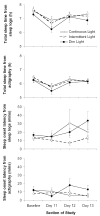Preflight adjustment to eastward travel: 3 days of advancing sleep with and without morning bright light
- PMID: 12932084
- PMCID: PMC1262683
- DOI: 10.1177/0748730403253585
Preflight adjustment to eastward travel: 3 days of advancing sleep with and without morning bright light
Abstract
Jet lag is caused by a misalignment between circadian rhythms and local destination time. As humans typically take longer to re-entrain after a phase advance than a phase delay, eastward travel is often more difficult than westward travel. Previous strategies to reduce jet lag have focused on shaping the perceived light-dark cycle after arrival, in order to facilitate a phase shift in the appropriate direction. Here we tested treatments that travelers could use to phase advance their circadian rhythms prior to eastward flight. Thus, travelers would arrive with their circadian rhythms already partially re-entrained to local time. We determined how far the circadian rhythms phase advanced, and the associated side effects related to sleep and mood. Twenty-eight healthy young subjects participated in 1 of 3 different treatments, which all phase advanced each subject's habitual sleep schedule by 1 h/day for 3 days. The 3 treatments differed in morning light exposure for the 1st 3.5 h after waking on each of the 3 days: continuous bright light (> 3000 lux), intermittent bright light (> 3000 lux, 0.5 h on, 0.5 off, etc.), or ordinary dim indoor light (< 60 lux). A phase assessment in dim light (< 10 lux) was conducted before and after the treatments to determine the endogenous salivary dim light melatonin onset (DLMO). The mean DLMO phase advances in the dim, intermittent, and continuous light groups were 0.6, 1.5, and 2.1 h, respectively. The intermittent and continuous light groups advanced significantly more than the dim light group (p < 0.01) but were not significantly different from each other. The side effects as assessed with actigraphy and logs were small. A 2-h phase advance may seem small compared to a 6- to 9-h time zone change, as occurs with eastward travel from the USA to Europe. However, a small phase advance will not only reduce the degree of re-entrainment required after arrival, but may also increase postflight exposure to phase-advancing light relative to phase-delaying light, thereby reducing the risk of antidromic re-entrainment. More days of preflight treatment could be used to produce even larger phase advances and potentially eliminate jet lag.
Figures



References
-
- Arendt J, Aldhous M, English J, Marks V, Arendt JH. Some effects of jet-lag and their alleviation by melatonin. Ergonomics. 1987;30:1379–1393.
-
- Aschoff J (1981) Circadian rhythms: interference with and dependence on work-rest schedules. In Biological Rhythms, Sleep and Shift Work, LC Johnson, DI Tepas, WP Colquhoun, and MJ Colligan, eds, pp 11–34, Spectrum, New York.
-
- Aschoff J, Hoffmann K, Pohl H, Wever R. Re-entrainment of circadian rhythms after phase shifts of the zeitgeber. Chronobiologia. 1975;2:23–78. - PubMed
-
- Baehr EK, Fogg LF, Eastman CI. Intermittent bright light and exercise to entrain human circadian rhythms to night work. Am J Physiol. 1999;277:R1598–R1604. - PubMed
-
- Boivin DB, Duffy JF, Kronauer RE, Czeisler CA. Dose-response relationships for resetting of human circadian clock by light. Nature. 1996;379:540–542. - PubMed
Publication types
MeSH terms
Substances
Grants and funding
LinkOut - more resources
Full Text Sources
Other Literature Sources
Research Materials

